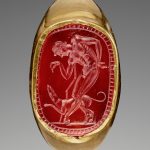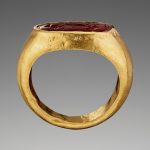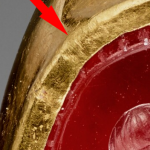(the pictures are thumbnails. Click them to view the images full size. )
As a jeweler and history enthusiast, I am a bit skeptical about this ring for many reasons.
I am going to begin with a link to the item on the J. Paul Getty Museum website: https://www.getty.edu/art/collection/object/103VPP?
“Engraved Gem with a Youth and his Dog inset into a Hollow Ring”
I have been seeing this ring image being shared around on the Internet and FaceBook recently and as a professional jeweler who studies historical jewelry manufacturing processes this item raises some red flags for me.
Lets start with the listed provenance: “Ariadne Galleries, Inc. (New York, New York), sold to the J. Paul Getty Museum, 1985.”
The Ariadne Galleries is an art gallery in New York City which is attributed for five items at the the J. Paul Getty Museum. I know the provenance ends here so as far as I know at this point, there is no history before 1985. I have sent an email to the art gallery to see if they have any records of this item before the sale to the museum. I will update this post with any replies.
A description from the J. Paul Getty Museum website.
Catalog number: 85.AN.165
Engraved Gem with a Youth and his Dog inset into a Hollow Ring
3rd–2nd century B.C.
Unknown artist/maker
On view at Getty Villa, Gallery 216, Roman Treasury
A nude youth leaning on a staff bends over to feed his dog on this Italic gem set into a hollow gold ring. The hatched border surrounding the scene and the use of small, drilled holes for details are typical for Italic gems of this period, as is the shape of the ring itself. The motif of a youth and his dog can be found on both Archaic Greek gems and Etruscan scarabs, and its appearance here is termed Archaistic, that is, intentionally old-fashioned.
At first glance it is a nice looking ring but as a bench jeweler I saw some things that made me pause. Then I looked closer and I kept seeing more that made me suspect that the carnelian set into this ring is not the original. I suspect it was replaced.
Below are the red flags that I saw with my observations.
red flag number 1
I know that I am not an expert on intaglio gems so I have no opinion on the authenticity of the gem. I do know that it is common for the replacement of gems to be done with an item that closely matches the original if possible. For historically significant items of jewelry, this can include sourcing replacements from gems that are from the same era as the original jewelry item as these will be the best match in style and patina. The first thing I noticed is that the gem is very uniformly shaped. While I can not see most of the girdle of the gem, the engraved border gives me a clue as to what the shape of the gem most likely is. A slightly boxed off oval with the radius on each of the four corners that are fairly uniform. I do know that there are plenty of 3rd to 2nd century intaglio cut carnelian gems on the market so sourcing one should not be a problem. I would guess that a gem that is the right age and approximate era was sourced as a replacement, put in, and the ring sold to the museum as one with the gem intact as it would be worth much more than a ring with an empty setting.
Now compare gem to the setting of the ring itself. A hollow ring, this looks to my eye like the gem was originally flush mounted (What used to be called a gypsy setting). When designing a ring you design it around the gem being used. This means the flush mounting of the gem will give it a uniform edge around the gem that matches the engraving giving the ring a visual balance and symmetry. The setting of this rings tells me a couple of things about the original gem. The left and right sides of the setting do not have the same curve. The left side is slightly flatter than the right. Also, the top of the left side has a smaller radius than the bottom left. This means the original gem this ring was made to hold most likely was not symmetrical left to right and top to bottom. This replacement appears as if the gem appears bezel-set by using the edge of the original setting.
red flag number 2
Look at the goldwork and patina at the sides and top of the ring. I would expect a historically significant jewelry item to show a uniformly random pattern of scratches and abrasions after being buried for two millennia. This one shows evidence of polishing to my eye. You can see where the top is slightly more polished around where the gold of the setting has been pushed down to set this gem into place. The patina seems to be directional in that the pattern has a definite horizontal direction.
Compare this to the other ring from the same art dealer in the museum. “Engraved Gem with a portrait of Demosthenes inset into a gold ring”
(https://www.getty.edu/art/collection/object/103WHD )
This gem is well set, the correct shape for the setting, and shows wear on the gem and the metal that I would expect from an artifact that had been buried for millennia.
Red flag number 3
This one is a glaring red flag as that the lines on the bezel do not show normal wear patterns. I would expect the same patina as the rest of the ring. On much of the bezel, the patina is very defined as well as the edges of the metal are very sharp and well defined. No wear is evident. A very telling clue is that the lines on the top of the setting radiate from the center to the outside edge.
Red flag number 4
This gem was too short for this setting and when it was put in as a replacement, the jeweler (And I use that term loosely) ended up filing away too much gold at the bottom attempting to make the gold lay over the edge of the gem. In this he made a huge gouge and you can see in the side view where the gold was pressed in to try and make the shoulder of the ring come close enough to the carnelian to make the gold lay over the edge. The jeweler failed in this. They only succeeded in removing gold and ruining the edge of the setting (red arrow).
I can also see the file and sanding marks that are attempting to replicate a worn patina that follows into the area where the bezel is missing. On the body of the ring these patina lines tend to run around the ring (red oval). They are too regular to be a normal patina from daily wear and tear or burial for millennia in my opinion. Contrast this with the lines on the top of the setting that radiate out from the edge.
Red flag number 5
Look at this gem as it sits in the original setting. This gem is thinner than the original. See where the conservators wax has gotten under the edge of the setting? There is no way this bezel would lift that uniformly while buried. I saw this and immediately thought this was a replacement gem. No question whatsoever. This gem is not original to this ring. The final clue is to look at the entire setting where the metal was pushed over the carnelian. After working so hard to make such a beautiful ring, how likely is it to expect the jeweler to only do a half-assed job on burnishing down the bezel? I suspect from the color of this ring that it is very high karat gold so it should burnish over easily. As a jewelry educator, if handed this by a student, I would not grade it. I would work with my student to achieve a passable quality of work. Yes, this carnelian is that poorly set into this ring. it would not receive a passable grade in a basic jewelry arts 101 level class.
Again, compare this to the ring referenced above that was sold to the J. Paul Getty Museum in 1990. (https://www.getty.edu/art/collection/object/103WHD )
I have sent emails to the Getty and the Ariadne Galleries. I will update this blog post with any replies that I receive.
DISCLAIMER:
All images in this post are from the webpage above and are in the Public Domain in the United States. The images may not be in the Public Domain under the laws of other countries. These opinions are based on the images from the Getty website. I have not personally inspected this ring and as such this blog post is my educated opinion but no more than that. I encourage the Getty to take this ring to a knowledgeable jeweler who is well versed in spotting fraudulent items and have an legally binding and official appraisal done.





